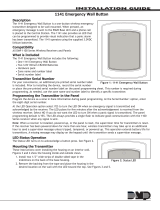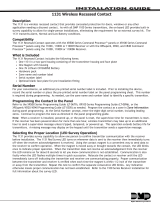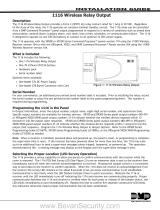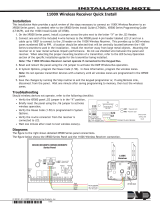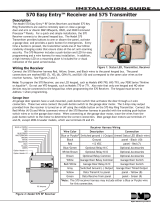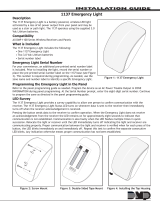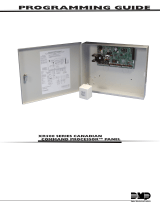Page is loading ...

INSTALLATION GUIDE
1100 Series Key Fob Transmitters
Description
The DMP 1100 Series Wireless Key Fob transmitters are available in a Four-Button (1145), Two-Button (1146), or
One-Button (1147) arrangement and are designed to be clipped to a key ring or lanyard. The 1100 Series Key Fobs
operate with the XR500 and XR100 Series Command Processor™ panels using the 1100X wireless receiver or with the
XRSuper6, XR20, or XR40 Command Processor™ panels using the 1100D wireless receiver. Key Fob features include
a durable water resistant housing, ergonomic button design for ease of use, and a status feedback LED for visual
conrmation. The button status LED responds with specic color-coded LED displays to indicate system status.
Each button can be individually programmed for one of nine different actions. Key fob programming defaults to the
typical use of the key fob such as Arming, Disarming, and Panic operations. Figure 1 shows the three key fob button
congurations and the table below identies the default programming for each button. Unique labels are available
to identify the use of each button. See Figure 2.
Connect
Key Ring or
Lany
ard Here
LED
Front View
Side View All Key Fobs
Left
Button
Top Button
Right
B
utton
Bottom
Button
Front
B
ack
Slot Location
1146 2-Button Layout
1147 1-Button Layout
Top
Button
Bottom
Button
1145 4-Button Layout
One
(Top)
B
utton
Figure 1: 1100 Series Key Fob Transmitters
What is Included
The 1100 Series Key Fob includes the following items:
• One key fob transmitter (1145, 1146, or 1147)
• One 3.0V lithium coin cell battery
• Peel-off button ID labels
• Serial number label
Key Fob Model
Button
Position
Default
Programming
1145 (Four-Button)
Top Arm
Bottom Disarm
Left Panic
Right
Arm Area 1 or
Perimeter
1146 (Two-Button)
Top Arm
Bottom Disarm
1147 (One-Button) Top Panic
www.BevanSecurity.com

Digital Monitoring Products 1100 Series Key Fob Installation Guide
2
1100 Series Key Fob Installation Guide Digital Monitoring Products
3
Transmitter Serial Number
For your convenience, an additional pre-printed serial number label is included. Prior to programming the device,
record the serial number or place the pre-printed serial number label on the 1100 Series Key Fob Programming Sheet
(LT-0706) included with the 1100X or 1100D wireless receiver. This number is required during programming.
Programming the Key Fob in the Panel
Refer to the XR500 Series Programming Guide (LT-0679), XR100 Series Programming Guide (LT-0896), or XRSuper6/
XR20/XR40 Programming Guide (LT-0305), and 1100 Series Key Fob Programming Sheet (LT-0706) as needed.
Program the key fob as a zone in Zone Information during panel programming. At the Serial Number prompt, enter
the eight-digit serial number, including the leading zero. Continue to program the zone as directed in the panel
programming guide. Should the default button operation need to be changed, the buttons can be reprogrammed to
operate as needed in panel zone programming.
Note: As an option, the key fob may be programmed to be supervised. When a receiver is installed, powered up,
or the panel is reset, the supervision time for transmitters, including key fobs is reset. If the receiver has been
powered down for more than one hour, wireless transmitters may take up to an additional hour to send a supervision
message unless a button is pressed. If programmed, this operation extends battery life. A missing message may
display on the keypad until the key fob sends a supervision message.
Labeling the Key Fob for Use
Attach the key fob transmitter to any key ring or lanyard. Select the peel-off
labels that display the programming for each button and place them onto the
corresponding key fob buttons for identication. See Figure 2. For easier label
installation, use a small at head screwdriver or X-acto knife to select the
label and apply it to the proper button location as shown in Figure 1. Button
labels can be changed if programming is changed.
LED Status Operation
Depending on the programmed action of a key fob button, the Status LED turns
on to acknowledge a button press or to indicate the armed state of the system.
• When the button is programmed for Panic, Panic 2, Emergency,
Emergency 2, Output, or Sensor Reset, a 1/2 second Green ash occurs
to acknowledge the button press.
• When the button is programmed for Arm, Disarm, Toggle arm/disarm,
or Status, the system armed status is received by the key fob and the
LED pulses once as shown in the table below.
LED Color Duration Description
Red 2.0 Seconds All System On
Green 2.0 Seconds All System Off
Green/Red 2.0 Seconds System On (Some Areas Armed)
When a button programmed as Unused is pressed, the LED does not operate.
Note: For best operation, allow the LED to turn on and then turn off before
pressing another button. The key fob may not complete sending the signal for
the button press if another button is pressed too soon.
Figure 2: Button Labels
Optional
Small or
Large
Labels are
available.
www.BevanSecurity.com

Digital Monitoring Products 1100 Series Key Fob Installation Guide
2
1100 Series Key Fob Installation Guide Digital Monitoring Products
3
Replacing the Battery
Observe polarity when installing the battery. Use only 3.0V coin
cell batteries, DMP Model CR2032, or the equivalent CR2032
battery from a local retail outlet.
1. Insert a small at head screwdriver into the slot at the key
fob end opposite the key ring and twist to separate the
key fob front and back sections.
2. Push and slide the old battery out of the holder in the
direction of the arrow to remove it. See Figure 3.
3. Verify the positive side of the battery is up.
4. Slide the new 3.0V Lithium battery into the holder and
push into place.
5. Snap the front and back sections back together.
Caution: Properly dispose of unused batteries. Do not
recharge, disassemble, heat above 212°F (100°C), or
incinerate. Risk of re, explosion, and burns.
Battery Life Expectancy
Typical battery life expectancy for DMP Model 1100 Series Key Fobs
is 2 years. DMP wireless equipment uses two-way communication
to extend battery life.
The following situations can reduce battery life expectancy:
• If a receiver is unplugged, too far away, or not installed.
Note: Transmitters continue to send supervision messages
until a receiver returns an acknowledgement.
After an hour the transmitter only attempts a supervision message every 60 minutes.
• Frequent transmissions, such as pressing a button multiple times.
The following situation can extend battery life expectancy:
• Extend transmitter supervision time in panel programming.
• Infrequent button presses.
Figure 3: 1100 Series Battery Location
Battery
Inside Battery
Compartment
Key Fob Front
Slot
Push Battery
Edge to Slide
B
attery Out
Insert Battery
with Po
sitive
Side Up
www.BevanSecurity.com

LT-0703 (11/06) © 2006 Digital Monitoring Products, Inc.
800-641-4282
www.dmp.com
Made in the USA
INTRUSION • FIRE • ACCESS • NETWORKS
2500 North Pa rt ne rs hi p Bo ul ev ar d
Springfield, Missouri 65803-8877
FCC Information
This device complies with Part 15 of the FCC Rules. Operation is subject to the following two conditions: (1) This
device may not cause harmful interference, and (2) this device must accept any interference received, including
interference that may cause undesired operation.
Changes or modications made by the user and not expressly approved by the party responsible for compliance could
void the user’s authority to operate the equipment.
NOTE: This equipment has been tested and found to comply with the limits for a Class B digital device, pursuant
to part 15 of the FCC Rules. These limits are designed to provide reasonable protection against harmful
interference in a residential installation. This equipment generates, uses and can radiate radio frequency
energy and, if not installed and used in accordance with the instructions, may cause harmful interference
to radio communications. However, there is no guarantee that interference will not occur in a particular
installation. If this equipment does cause harmful interference to radio or television reception, which
can be determined by turning the equipment off and on, the user is encouraged to try to correct the
interference by one or more of the following measures:
- Reorient or relocate the receiving antenna.
- Increase the separation between the equipment and receiver.
- Connect the equipment into an outlet on a circuit different from that to which the receiver is connected.
- Consult the dealer or an experienced radio/TV technician for help.
Note: The 1100 Series wireless system is a two-way supervised wireless design. It is compliant with FCC rules as
they pertain to 900 MHz Spread Spectrum devices. In rare instances it has been observed that certain 900 MHz
cordless telephones may occasionally experience a clicking sound on the telephone while in use. If this occurs, it
may be resolved by selecting a different channel on the cordless telephone, or replacing the cordless phone with a
different brand or model of 900 MHz telephone or other cordless telephone.
Specications
Battery
Life Expectancy 2 years
Type 3.0V lithium CR2032
See Battery Life Expectancy for full details.
Dimensions
1.98” H x 1.98” W x 0.6” D
Color Black
Housing Material ABS Plastic
Compatibility
1100X Wireless Receiver Version 101 or higher with
XR500 Series Version 113 or higher
XR100 Series Version 113 or higher
1100D Wireless Receiver Version 103 or higher with
XRSuper6, XR20, or XR40 Version 302 or higher
1100X and 1100D version label is located on the lower left
side of the Receiver PCB.
Patents
Patent(s) Pending
Listings and Approvals
FCC Part 15 Registration ID CCKPC0098
www.BevanSecurity.com
/
